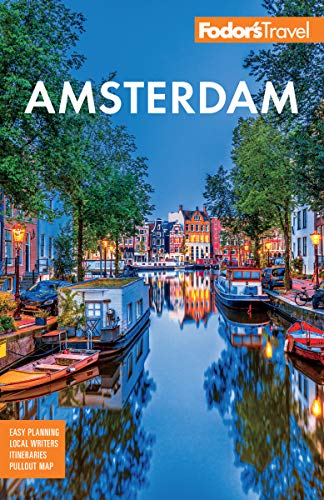Public Transport
The Gemeentelijk Vervoerbedrijf (GBV) runs Amsterdam's public transport system, which includes the metro (subway), buses, trams, and ferries. It's safe, reliable, and besides your own two feet (and bikes, for the daring), the best way to get around Amsterdam. As of June 1, 2020, passengers age 13 and over must wear non-medical face masks on all public transport. The fine for not wearing a mask is €95.
Ferries
Three GVB ferry lines transport pedestrians, cyclists, and motorcyclists from Centraal Station across the IJ channel to Amsterdam Noord. The two of the most interest to tourists are Buiksloterwegveer, a five-minute ferry that runs 5–14 times an hour, 24 hours a day, and stops by the EYE Film museum and A'DAM Lookout tower, and NDSM-wharf, a 14-minute ferry that runs 2-4 times an hour, daily until midnight, to the NDSM warehouse district; the third ferry goes to IJplein. All ferries are free of charge.
Metro
Amsterdam has a subway system, called the metro, which runs for 43 km (27 miles) and includes 39 stations. There are five metro lines (M50/M51/M52/M53/M54) that serve Amsterdam and the surrounding suburbs. The most useful for visitors is the M52 North-South line, which runs from Noord in the north to Zuid in the south, making stops at Centraal Station, Rokin, Vijzelgracht, De Pijp, and Europaplein (RAI); it can be much faster than taking a tram. The M51, M53, and M54 all begin at Centraal Station and are useful for getting to Nieuwmarkt, Waterlooplein, and Amstel.
Trams and Buses
Amsterdam has 15 tram routes and 35 bus routes, many starting from the hub at Centraal Station. A large bus depot is also on the Marnixstraat, across from the main police station. Trams and buses run daily, about 6 am–12:30 am. The tram routes, with a network of 200 km (124 miles) of track, make this form of transport more useful than the bus for most tourists. Night owls can make use of the hourly night-bus services, some of which double frequency on Friday and Saturday night.
Between stops, trams brake only when absolutely necessary, so listen for warning bells if you are walking or cycling near tramlines. Taxis often use tramlines, but other cars are allowed onto them only when turning right. As with all urban systems of transportation, keep an eye out for pickpockets.
Tram Nos. 2, 4, 11, 12, 13, 14, 17, 24, and 26 all start and end their routes at Centraal Station. The trams that are most frequently used by visitors are the Nos. 2 and 12, which stop at the big central Dam Square and, along with No. 11, also stop at Leidseplein square. The Nos. 2, 3, 5, and 12 will get you to Museumplein (or Rijksmuseum) and the Museum District. Tram Nos. 2, 5, and 24 travel through Amsterdam's chic Oud-Zuid district. The Nos. 12 and 24 trams stop in De Pijp, and the No. 4 will take you to the RAI convention center.
The GVB buses cover all the city's neighborhoods and are a good way to get closer to specific addresses.
Tickets
To get around by bus, tram, or metro you'll need an OV-chipkaart (public transport chip card)—an electronic payment system, which you hold up to a detector each time you board and leave any bus or tram. You can buy them "empty" or preloaded at NS train stations, GVB offices, some magazine kiosks, and supermarkets. An empty card costs €7.50; be sure to load credit onto it immediately, as you'll need a minimum of €4 to ride the bus, metro, or tram, and a minimum of €20 for the train. The cards are debited according to the distance traveled; you can add value to them at machines in the stations. Visit the OV-chipkaart website (www.ov-chipkaart.nl) or call the help desk (0900/8011) for more information. You can also buy one-hour tickets from bus or tram drivers, although this works out to be more expensive. The OV-chipkaart can also be used on trains (the check-in/check-out detectors for the trains are clearly marked and in the railway stations, not on board). You have to activate your card for rail travel at one of the OV ticket machines at a railway station. Teams of ticket inspectors occasionally make spot checks on trams and buses. This doesn't happen often, but if you are checked and your OV-chipkaart hasn't been checked in, you face a fine.
Besides the OV-chipkaart system, in Amsterdam you can also buy 24-, 48-, 72-, 96-, 120-, 144-, and 168-hour travel-anywhere tickets (€8 for one day, €13.50 for two days, €19 for three days, €24.50 for four days, €29.50 for five days, €34 for six days, €37 for seven days), which cover all urban bus and tram routes operated by the GVB. Fares are reduced for children ages 4–11 and for people 65 and older.
The electronic I amsterdam City Card provides free or discounted admission to many top attractions, including museums and a canal cruise, and free use of public transport. These can be bought online or from tourist offices in Amsterdam, and cost €65 for one day, €85 for two days, €105 for three days, €120 for four days, and €130 for five days.




